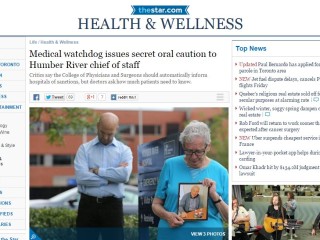Heard: September 18-19, 2018
Decision released: March 15, 2019
Headline: Court of Appeal Rejects Tort of Harassment
Summary:
In this unanimous Court of Appeal for Ontario decision, a three-judge panel consisting of Justices R.G Juriansz J.A., D. Brown J.A., and G. Huscroft J.A. considered whether it was appropriate for the Trial Judge to recognize a new freestanding tort of harassment and found that the lower court erred in doing so.
Background Facts:
The plaintiff in this case, a member of the Royal Canadian Mounted Police (RCMP), launched a claim against his employer, the Government of Canada, for bullying and harassment that he allegedly experienced from managerial members of the RCMP over a seven-year period during his employment with the RCMP.
The Trial Decision:
The Trial Judge in the case set out a four-pronged test which a plaintiff must meet in order to establish a claim for damages for harassment:
1) Was the conduct of the defendants towards the plaintiff outrageous?
2) Did the defendants intend to cause emotional distress or did they have
reckless disregard for causing the plaintiff to suffer emotional distress?
3) Did the plaintiff suffer from severe or extreme emotional distress?
4) Was the outrageous conduct of the defendants the actual or proximate
cause of the emotional distress?
The Trial Judge in this case found that the plaintiff had satisfied the four-pronged test and concluded that the plaintiff in this case had suffered from depression and post-traumatic stress disorder (PTSD) as a result of the RCMP’s actions.
The Trial Judge also concluded that the plaintiff met the test for IIMS.
Analysis:
The Court of Appeal panel acknowledged that this was the first case in which the Court was being asked to determine whether a tort of harassment exists.
The Court was critical of the fact that the parties did not canvass what is required for a new tort to be recognized. On this issue the Court relied on the reasoning of Supreme Court Justice McLachlin J. in Watkins v. Olafson, [1989] 2 S.C.R. 750 (Watkins) to emphasize that “Over time, the law in any given area may change; but the process of change is a slow and incremental one, based largely on the mechanism of extending an existing principle to new circumstances.”
The Court of Appeal relying on the Supreme Court of Canada’s ruling in Watkins reiterated that significant changes in the law are best left to the legislature. Quoting from Watkins the Panel held that “The court has before it a single case; major changes in the law should be predicated on a wider view of how the rules will operate in the broad generality of cases … more importantly, there is the long-established principle that in a constitutional democracy it is the legislature, as the elected branch of government, which should assume the major responsibility for law reform.”
The Panel explained that when the Supreme Court of Canada recognized a duty of honest contractual performance in Bhasin v. Hrynew, 2014 SCC 71, [2014] 3 S.C.R. 494, it was an incremental step that followed from the recognition of good faith contractual performance as an underpinning of existing common law rules.
Similarly, the Panel explained that recognition of the tort of intrusion upon seclusion in Ontario in Jones v. Tsige, 2012 ONCA 32, 108 O.R. (3d) 241, was an incremental step consistent with the role of the court to develop the common law in a manner consistent with the changing needs of society. It was recognized in the face of a case which “cried out for remedy” and in an emerging acceptance of claims for breach of privacy, and provincial legislation that established a right to privacy.
The Court of Appeal then canvassed at paragraphs 27-36 other Canadian cases which make reference to the possible existence of a tort of harassment and rejected an interpretation of those cases as having established the tort or its requisite elements.
The Panel at paragraphs 41-42 denied that the situation in this case was one which cried out for a remedy as was the case in Jones v. Tsige and found that the well-established tort of IIMS in Ontario offers a remedy to the alleged conduct at issue in the case.
The test for IIMS is met when a plaintiff establishes that the conduct of the defendant was:
1) Flagrant and outrageous;
2) Calculated to produce harm; and which
3) Resulted in visible and provable illness.
The Court reiterates that IIMS is an intentional tort requiring the plaintiff to prove there was a subjective intention on the part of the defendant to cause the harm which occurred.
The Court compared the elements of the proposed tort of harassment and acknowledged that the requirements of such a tort would be less onerous than establishing IIMS, as it would be a negligence-based tort, as compared to the intention-based IIMS. The Court recognized the distinction between the two torts in two key respects as follows:
1) The tort of harassment would not require subjective intention but
could also be established based on objectively defined reckless
disregard by the defendant for the harm caused by his/her conduct.
2) Establishing a proximate cause for a visible and provable illness
would be more cumbersome than establishing a proximate cause for
severe or extreme emotional distress.
The Court goes on in this case to hold, that although the tort of IIMS exists in cases such as this as a long-established remedy, the trial judge erred in ruling the plaintiff had met the test for IIMS in this case. The Panel at paragraph 60 ruled that the plaintiff failed to meet each of the first three prongs of the test for IIMS. The Panel also found that due to palpable and overriding errors of fact, the plaintiff likely would not have met the test for the tort of harassment as set out by the trial judge either, as the plaintiff had failed to establish a causal connection between the alleged harm caused and the alleged conduct of the defendant.
Interestingly the Court of Appeal does not completely close the door on the establishment of a tort of harassment but rather ruled that this was not the appropriate case in which to do so.
At this time it remains to be seen whether the plaintiff will seek leave from the Supreme Court of Canada to appeal the decision.













